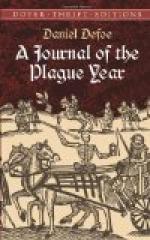These things, however, put off all my thoughts of going into the country; and my brother also being gone, I had no more debate either with him or with myself on that subject.
It was now mid-July; and the plague, which had chiefly raged at the other end of the town, and, as I said before, in the parishes of St. Giles’s, St. Andrew’s, Holborn, and towards Westminster, began now to come eastward, towards the part where I lived. It was to be observed, indeed, that it did not come straight on towards us; for the city, that is to say within the walls, was indifferent healthy still. Nor was it got then very much over the water into Southwark; for though there died that week twelve hundred and sixty-eight of all distempers, whereof it might be supposed above nine hundred died of the plague, yet there was but twenty-eight in the whole city, within the walls, and but nineteen in Southwark, Lambeth Parish included; whereas in the parishes of St. Giles and St. Martin’s-in-the-Fields alone, there died four hundred and twenty-one.
But we perceived the infection kept chiefly in the outparishes, which being very populous and fuller also of poor, the distemper found more to prey upon than in the city, as I shall observe afterwards. We perceived, I say, the distemper to draw our way, viz., by the parishes of Clerkenwell, Cripplegate, Shoreditch, and Bishopsgate; which last two parishes joining to Aldgate, Whitechapel, and Stepney, the infection came at length to spread its utmost rage and violence in those parts, even when it abated at the western parishes where it began.
It was very strange to observe that in this particular week (from the 4th to the 11th of July), when, as I have observed, there died near four hundred of the plague in the two parishes of St. Martin’s and St. Giles-in-the-Fields[34] only, there died in the parish of Aldgate but four, in the parish of Whitechapel three, in the parish of Stepney but one.
Likewise in the next week (from the 11th of July to the 18th), when the week’s bill was seventeen hundred and sixty-one, yet there died no more of the plague, on the whole Southwark side of the water, than sixteen.
But this face of things soon changed, and it began to thicken in Cripplegate Parish especially, and in Clerkenwell; so that by the second week in August, Cripplegate Parish alone buried eight hundred and eighty-six, and Clerkenwell one hundred and fifty-five. Of the first, eight hundred and fifty might well be reckoned to die of the plague; and of the last, the bill itself said one hundred and forty-five were of the plague.




